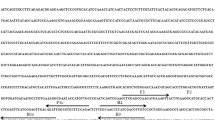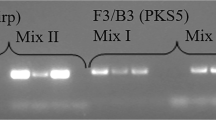Abstract
Tomato bacterial speck, caused by Pseudomonas syringae pv. tomato (Pst), is one of the most devastating bacterial diseases in tomato worldwide. To establish a rapid amplification system for the detection of Pst, a loop-mediated isothermal amplification (LAMP) method, which includes two external primers (F3/B3), two internal primers (FIP/BIP) and one backward loop primer (B-Loop), was designed based on the hrpZ gene. The specificity of the LAMP primer set was widely validated on Pst and non-target strains. The conditions for LAMP detection of Pst were optimized to complete in 60 min at 63 °C. The amplification was confirmed through gel electrophoresis or visual inspection using calcein. In the sensitivity test, the detection limit of the LAMP assay was 1.61 × 10 fg μL−1 for genomic DNA and 1.05 × 103 CFU mL−1 for bacterial suspension without DNA extraction. The novel method was also applied for the detection of Pst in artificially and naturally infected tomato leaf and stem tissue samples, and even the early onset of disease could be detected by the assay. This method can rapidly detect Pst-infected tissues without strain enrichment and complex DNA extraction, and hence, it is suitable for quarantine and field detection.







Similar content being viewed by others
References
Alfano, J. R., & Collmer, A. (1997). The type III (Hrp) secretion pathway of plant pathogenic bacteria: trafficking harpins, Avr proteins, and death. Journal of Bacteriology, 179, 5655–5662.
Bashan, Y., Okon, Y., & Henis, Y. (1978). Infection studies of Pseudomonas tomato, causal agent of bacterial speck of tomato. Phytoparasitica, 6, 135–143.
Bender, C. L., Alarcón Chaidez, F., & Gross, D. C. (1999). Pseudomonas syringae phytotoxins: mode of action, regulation, and biosynthesis by peptide and polyketide synthetases. Microbiology and Molecular Biology Review, 63, 266–292.
Braun-Kiewnick, A., & Sands, D. C. (2001). Pseudomonas. In N. W. Schaad, J. B. Jones, & W. Chun (Eds.), Laboratory guide for identification of plant pathogenic Bacteria (3rd ed., pp. 84–120). St. Paul: APS Press.
Brown, D. G., & Allen, C. (2004). Ralstonia solanacearum genes induced during growth in tomato: an inside view of bacterial wilt. Molecular Microbiology, 53, 1641–1660.
Bryan, M. K. (1933). Bacterial speck of tomatoes. Phytopathology, 23, 897–904.
Bühlmann, A., Pothier, J. F., Rezzonico, F., Smits, T. H. M., Andreou, M., Boonham, N., Duffy, B., & Frey, J. E. (2013a). Erwinia amylovora loop-mediated isothermal amplification (LAMP) assay for rapid pathogen detection and on-site diagnosis of fire blight. Journal of Microbiological Methods, 92, 332–339.
Bühlmann, A., Pothier, J. F., Tomlinson, J. A., Frey, J. E., Boonham, N., Smits, T. H. M., & Duffy, B. (2013b). Genomics-informed design of loop-mediated isothermal amplification for detection of phytopathogenic Xanthomonas arboricola pv. pruni at the intraspecific level. Plant Pathology, 62, 475–484.
Cuppels, D. A., Moore, R. A., & Morris, V. L. (1990). Construction and use of a nonradioactive DNA hybridization probe for detection of Pseudomonas syringae pv. tomato on tomato plants. Applied and Environmental Microbiology, 56, 1743–1749.
Fanelli, V., Cariddi, C., & Finettisialer, M. (2007). Selective detection of Pseudomonas syringae pv. tomato using dot blot hybridization and real-time PCR. Plant Pathology, 56, 683–691.
Gill, P., & Ghaemi, A. (2008). Nucleic acid isothermal amplification technologies: a review. Nucleosides Nucleotides & Nucleic Acids, 27, 224–243.
Hodgetts, J., Hall, J., Karamura, G., Grant, D. J., Studholme, D. J., Boonham, N., Karamura, E., & Smith, J. J. (2015a). Rapid, specific, simple, in-field detection of Xanthomonas campestris pathovar musacearum by loop-mediated isothermal amplification. Journal of Applied Microbiology, 119, 1651–1658.
Hodgetts, J., Karamura, G., Johnson, G., Hall, J., Perkins, K., Beed, F., Nakato, V., Grant, M., Studholme, D. J., Boonham, N., & Smith, J. (2015b). Development of a lateral flow device for in-field detection and evaluation of PCR-based diagnostic methods for Xanthomonas campestris pv. musacearum, the causal agent of banana xanthomonas wilt. Plant Pathology, 64, 559–567.
Jaramillo, A., Huertas, C. A., & Gómez, E. D. (2017). First report of bacterial stem rot of tomatoes caused by Pectobacterium carotovorum subsp. brasiliense in Colombia. Plant Disease, 101, 830.
Kil, E. J., Kim, S., Lee, Y. J., Kang, E. H., Lee, M., Cho, S. H., Kim, M. K., Lee, K. Y., Heo, N. Y., Choi, H. S., Kwon, S. T., & Lee, S. (2015). Advanced loop-mediated isothermal amplification method for sensitive and specific detection of Tomato chlorosis virus using a uracil DNA glycosylase to control carry-over contamination. Journal of Virological Methods, 213, 68–74.
Meng, X. L., Xie, X. W., Shi, Y. X., Chai, A. L., Ma, Z. H., & Li, B. J. (2016). Evaluation of a loop-mediated isothermal amplification assay based on hrpZ gene for rapid detection and identification of Pseudomonas syringae pv. lachrymans in cucumber leaves. Journal of Applied Microbiology, 122, 441–449.
Mori, Y., Kitao, M., Tomita, N., & Notomi, T. (2004). Real-time turbidimetry of LAMP reaction for quantifying template DNA. Journal of Biochemical and Biophysical Methods, 59, 145–157.
Notomi, T., Okayama, H., Masubuchi, H., Yonekawa, T., Watanabe, K., Amino, N., & Hase, T. (2000). Loop-mediated isothermal amplification of DNA. Nucleic Acids Research, 28, e63.
Romero, A. M., Vega, D., Pizzorno, R., Cordon, G., & Correa, O. S. (2018). Hydraulic and leaf reflectance alterations induced by Clavibacter michiganensis subsp. michiganensis on tomato plants. European Journal of Plant Pathology, 152, 567–572.
Schrader, C., Schielke, A., Ellerbroek, L., & Johne, R. (2012). PCR inhibitors-occurrence, properties and removal. Journal of Applied Microbiology, 113, 1014–1026.
Shenge, K. C., Stephan, D., Mabagala, R. B., Mortensen, C. N., & Wydra, K. (2008). Molecular characterization of Pseudomonas syringae pv. tomato isolates from Tanzania. Phytoparasitica, 36, 338–351.
Takahashi, R., Fukuta, S., Kuroyanagi, S., Miyake, N., Nagai, H., Kageyama, K., & Ishiguro, Y. (2014). Development and application of a loop-mediated isothermal amplification assay for rapid detection Pythium helicoides. FEMS Microbiology Letters, 355, 28–35.
Tamura, K., & Nei, M. (1993). Estimation of the number of nucleotide substitutions in the control region of mitochondrial DNA in humans and chimpanzees. Molecular Biology and Evolution, 10, 512–526.
Tomita, N., Mori, Y., Kanda, H., & Notomi, T. (2008). Loop-mediated isothermal amplification (LAMP) of gene sequences and simple visual detection of products. Nature Protocols, 3, 877–882.
Trantas, E. A., Sarris, P. F., Mpalantinaki, E. E., Pentari, M. G., Ververidis, F. N., & Goumas, D. E. (2013). A new genomovar of Pseudomonas cichorii, a causal agent of tomato pith necrosis. European Journal of Plant Pathology, 137, 477–493.
Varma, A. (2007). Plant genomic DNA isolation: An art or science. Biotechnology Journal, 2, 386–392.
Young, J. M., Saddler, G. S., Takikawa, Y., de Boer, S. H., Vauterin, L., Gvozdyak, R. I., & Stead, D. E. (1996). Names of plant pathogenic bacteria 1863-1995-the ISPP accepted list of bacterial names. Review Plant Pathology, 75, 721–763.
Yunis, H., Bashan, Y., Okon, Y., & Henis, Y. (1980). Weather dependence yield losses and control of bacterial speck of tomato caused by Pseudomonas tomato. Plant Disease, 64, 937–939.
Zaccardelli, M., Spasiano, A., Bazzi, C., & Merighi, M. (2005). Identification and in planta detection of Pseudomonas syringae pv. tomato using PCR amplification of hrpZPst. European Journal of Plant Pathology, 111, 85–90.
Zhang, S. Y., Dai, D. J., Wang, H. D., & Zhang, C. Q. (2019). One-step loop-mediated isothermal amplifcation (LAMP) for the rapid and sensitive detection of Fusarium fujikuroi in bakanae disease through NRPS31, an important gene in the gibberellic acid bio-synthesis. Scientific Reports, 9, 3726.
Zhao, M. M., Shi, Y. H., Wu, L., Guo, L. C., Liu, W., Xiong, C., Yan, S., Sun, W., & Chen, S. L. (2016). Rapid authentication of the precious herb saffron by loop-mediated isothermal amplification (LAMP) based on internal transcribed spacer 2 (ITS2) sequence. Scientific Reports, 6, 25370.
Acknowledgements
This work was supported by the National key research & development (R&D) plan (No. 2017YFD0200300), the Science and Technology Innovation Program of the Chinese Academy of Agricultural Sciences (No. CAAS-ASTIP-IVFCAAS), and Modern Agro-industry Technology Research System in China (No. CARS-25).
Author information
Authors and Affiliations
Corresponding authors
Ethics declarations
Conflict of interest
The authors declare that they have no conflict of interest.
Ethical approval
This study does not contain any studies with human participants or animals performed by any of the authors.
Rights and permissions
About this article
Cite this article
Chen, ZD., Kang, HJ., Chai, AL. et al. Development of a loop-mediated isothermal amplification (LAMP) assay for rapid detection of Pseudomonas syringae pv. tomato in planta. Eur J Plant Pathol 156, 739–750 (2020). https://doi.org/10.1007/s10658-019-01923-8
Accepted:
Published:
Issue Date:
DOI: https://doi.org/10.1007/s10658-019-01923-8




